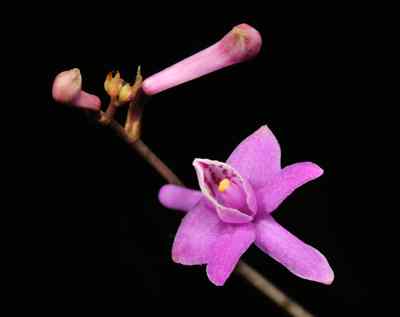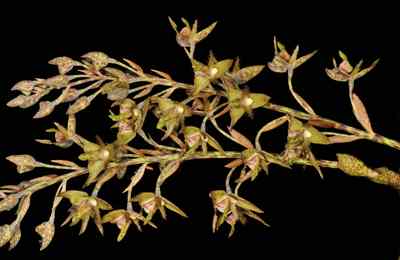The Plant
Epiphyte. Stem 4 to 7 feet long, stout, pendulous, roots thick and long. Leaves arranged alternatively, oblong, sessile, with sheathed and clasping base, bifid at the apex, 5 to 8 cm long and 1.5 to 2 cm in width. Flowers in leaf opposed stout 12 to 16 cm long racemes.
The Flower
Flowers very attractive, large, around 3 to 4 cm across, 4 to 5 in numbers, attached in distance and arising from a node like structure in the raceme enclosed in a clasping bract. Sepals unequal; dorsal oblong and blunt, erect; lateral oblong, falcate, spreading. Petals slightly shorter and narrower than the lateral sepals, oblong, minutely arching down, spreading. Margins of sepals and petals towards their apex are curved up ending in a deflexed beak tip.
Sepals and petals are yellowish brown up to two-third of its length from the base, with broad chestnut brown half broken horizontal bands, the upper one-third totally chestnut brown. Lip yellowish brown to orange base throughout, the side lobes of the hypochile with chestnut brown vertical bands, its disc white with two brilliant brown elongated patches; epichile with white diverging bands. The apex of the anther with pinkish brown margins.

The Pursuit
Undoubtedly, this one of the most beautiful orchid flower of the region. As the saying goes, “beauty is sometimes a curse” is most appropriate for this species as it was collected in plenty for trade due to its beauty, thus making it almost on the verge of extinction from the wild. I had seen this species in bloom in many houses and nurseries of the region, but there was something missing in those flowers. Although King and pantling used to the term “magnificent” to describe the flowers of this genus, I felt they are gloomy.
I was determined to find this species from its natural habitat. More importantly, I am the only person who had documented and studied the other two species of this genus from the region; hence it was more important for me to find this species also. (Note: In the days of King and Pantling, there were three species under Arachnanthe genus from the region).
I know a couple of places of its nearest ally of this species, Esmeralda cathcartii (Lindl) Rchb. My initial thoughts of finding this species in those locations were not right. King and Pantling’s mention about this species growing at higher altitudes than its ally and blooms in a different season made me shift my search to some other locations. I searched vast areas inside a semi tropical forest for weeks. During that search I found many other species but this one remained elusive. The search month coincided with many religious festivals of the region and getting somebody to accompany me was really impossible. All my accomplices were either on official or “unofficial” leave. As the region was inside a protected area and with enough wildlife, venturing inside all alone was not allowed. Even though the region of Sikkim-Himalayas is very small in area, there are many places where no humans have ever ventured. It is interesting to note that many of theses places are inside protected areas, which are to be monitored regularly by its staff in the form of patrols. Taking into consideration the blooming time of the species and my curiosity to find it, the in-charge official of the area somehow arranged a casual official to accompany me for a few days. He was such a lazy man; we never got along very nicely. However, as the saying goes, “something is better than nothing”, I took advantage of his presence and went deep inside the unexplored areas. The search went on for several days without any success. But I never gave up, one day as we were returning to the base camp in a patrol trek, I found two long pendulous stems of this species swinging in the light evening breeze right above our head from a huge tree. The stems were more than 6 feet long and curved down. It was a joyous moment of my entire days there. I never thought I would find the species with such ease. As the days were very short during those months we decided to return to the camp and come back next day to study the plant. Next day we were there before afternoon, and found there were 6 buds coming up and it would take quite some time to be in flower. I visited the plant several times in the next one month to see them in bloom and produced this wonderful photograph.
The area is a habitat of many bears and leopards. There was a recent report of a leopard attack on a patrolling party. However, with the grace of the Almighty in the almost 48 days I worked there, I never encountered any big wild animals.
Reference:
Arachnanthe clarkei Rolfe., Page no 209 – 210 of The Orchids of the Sikkim-Himalayas by Sir. George King and Robert Pantling (1898).



